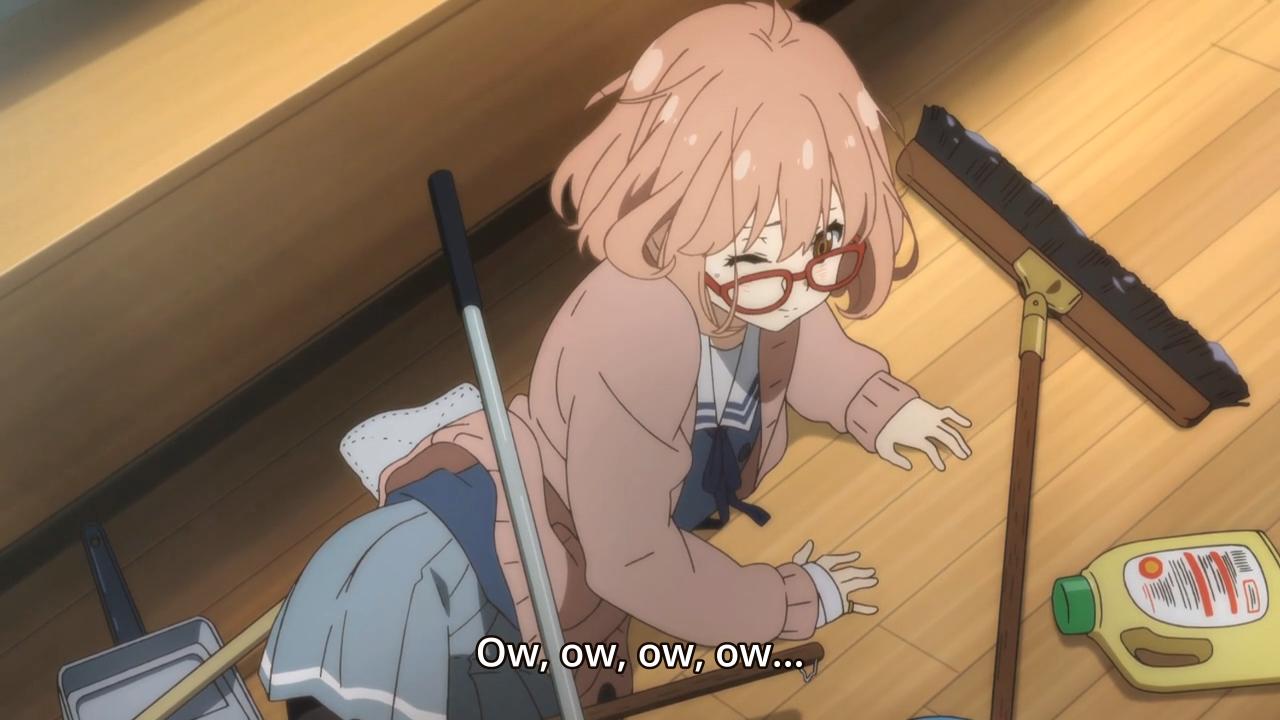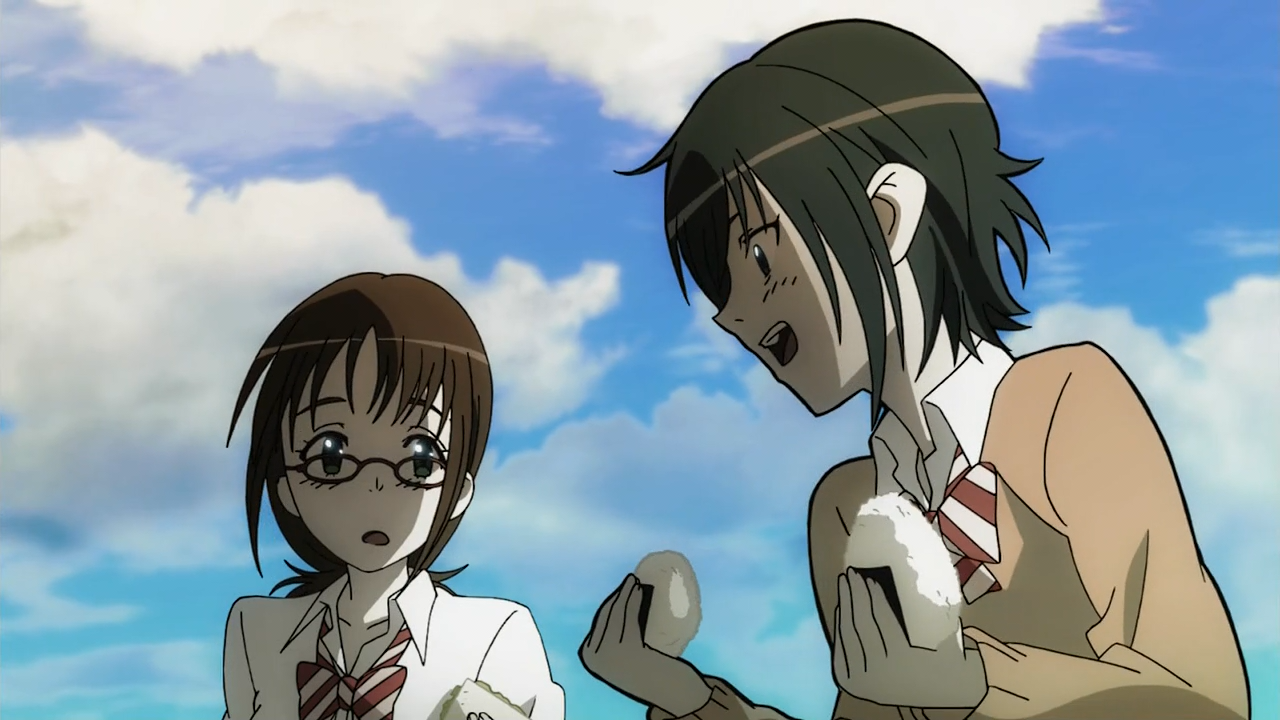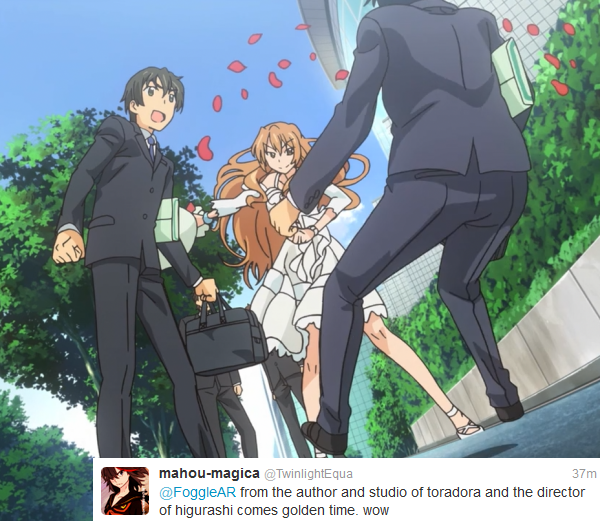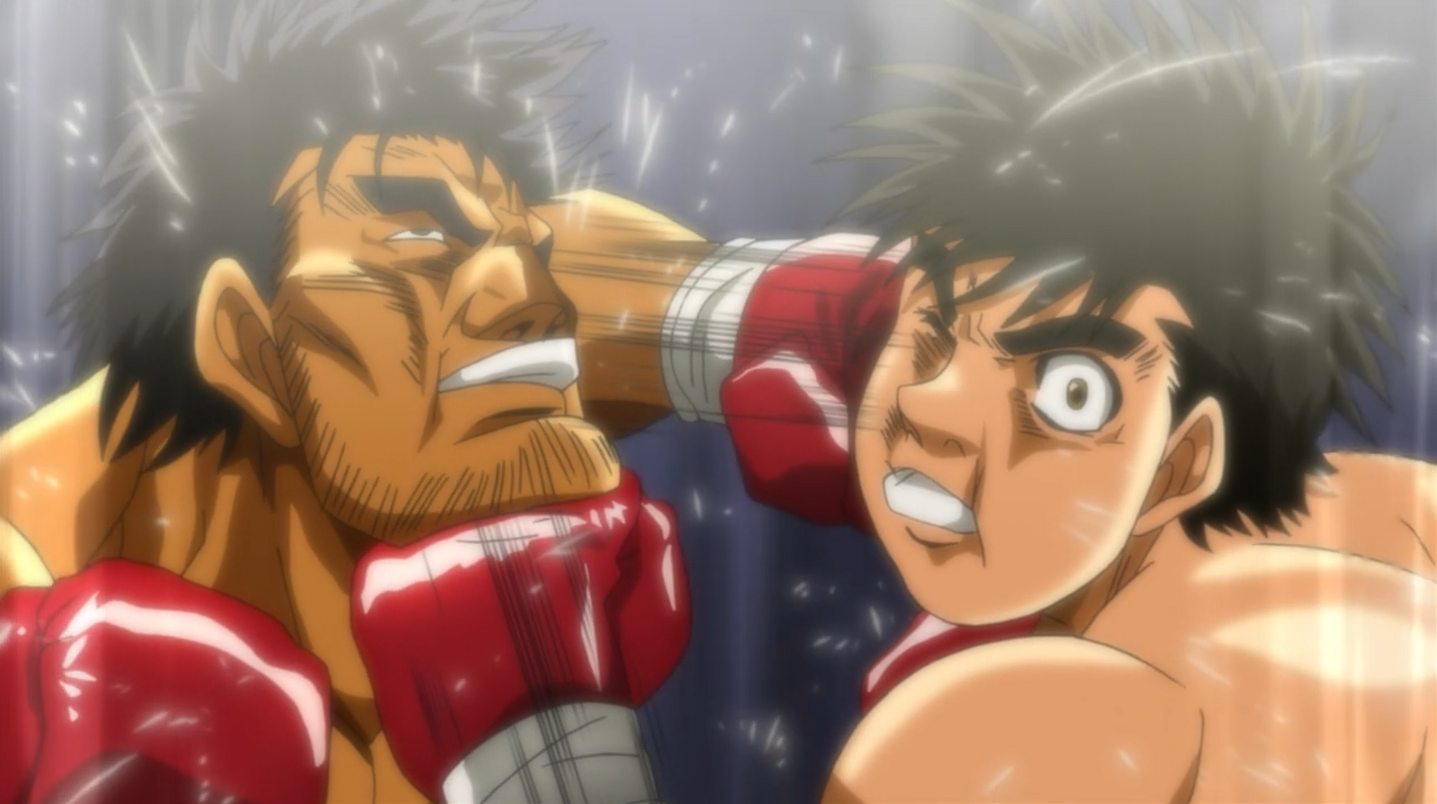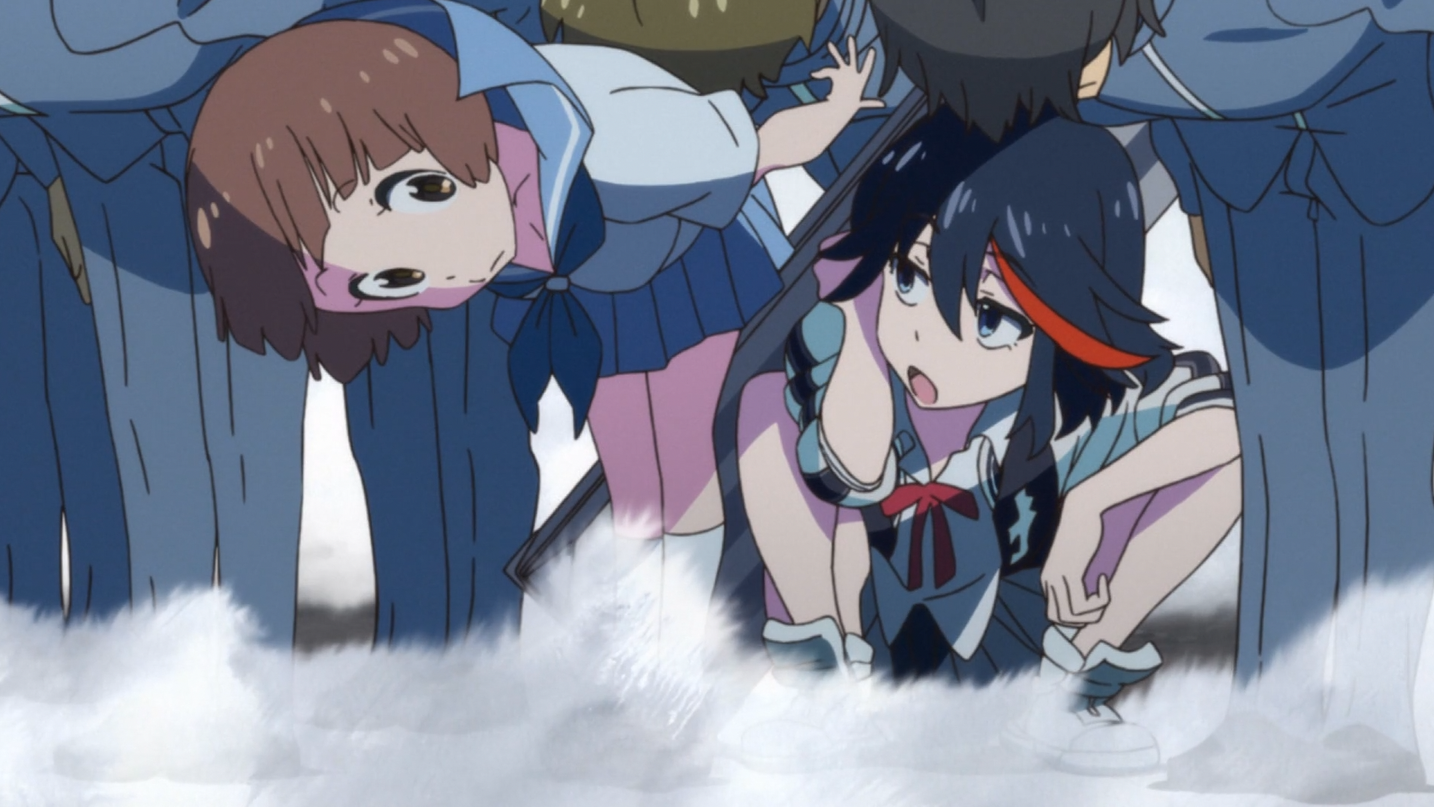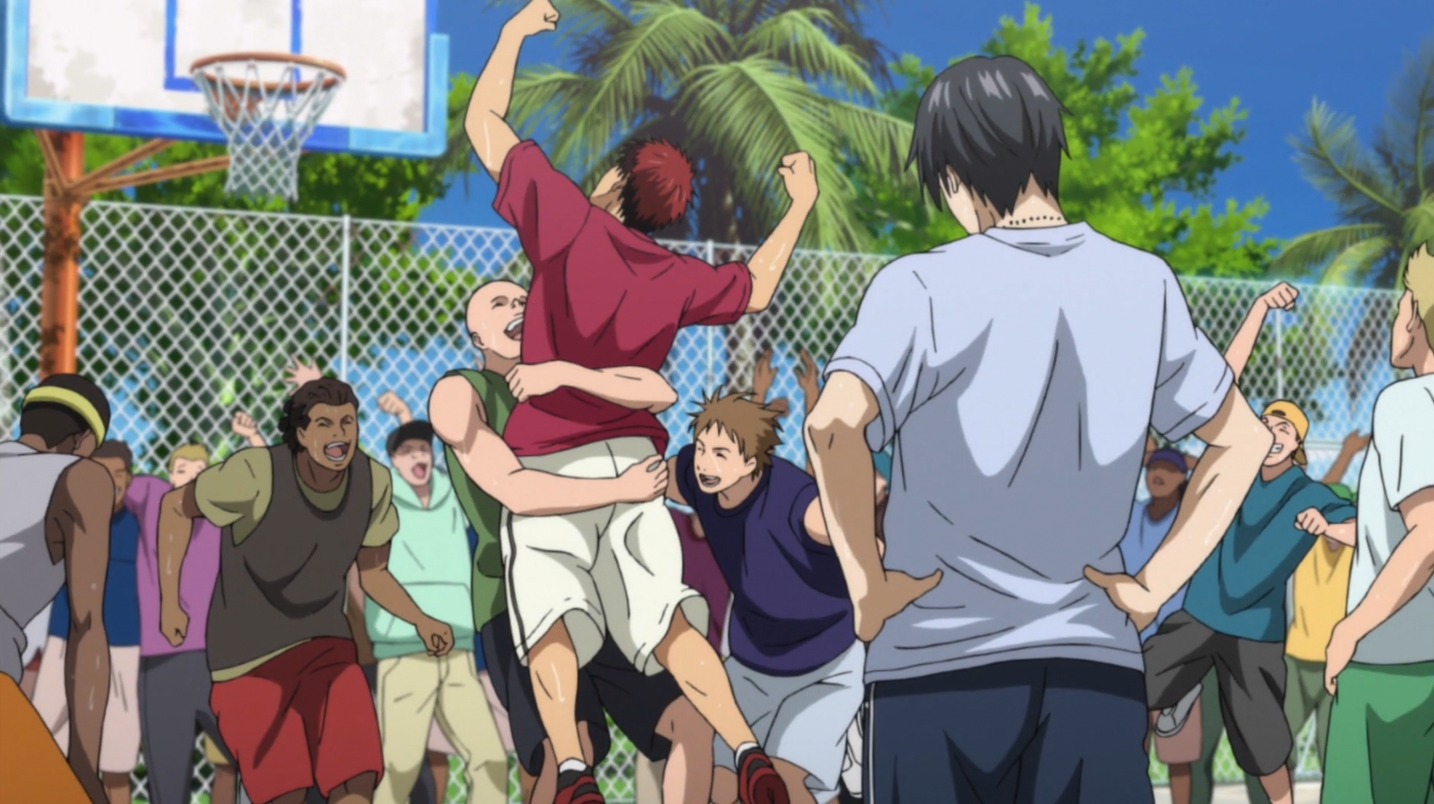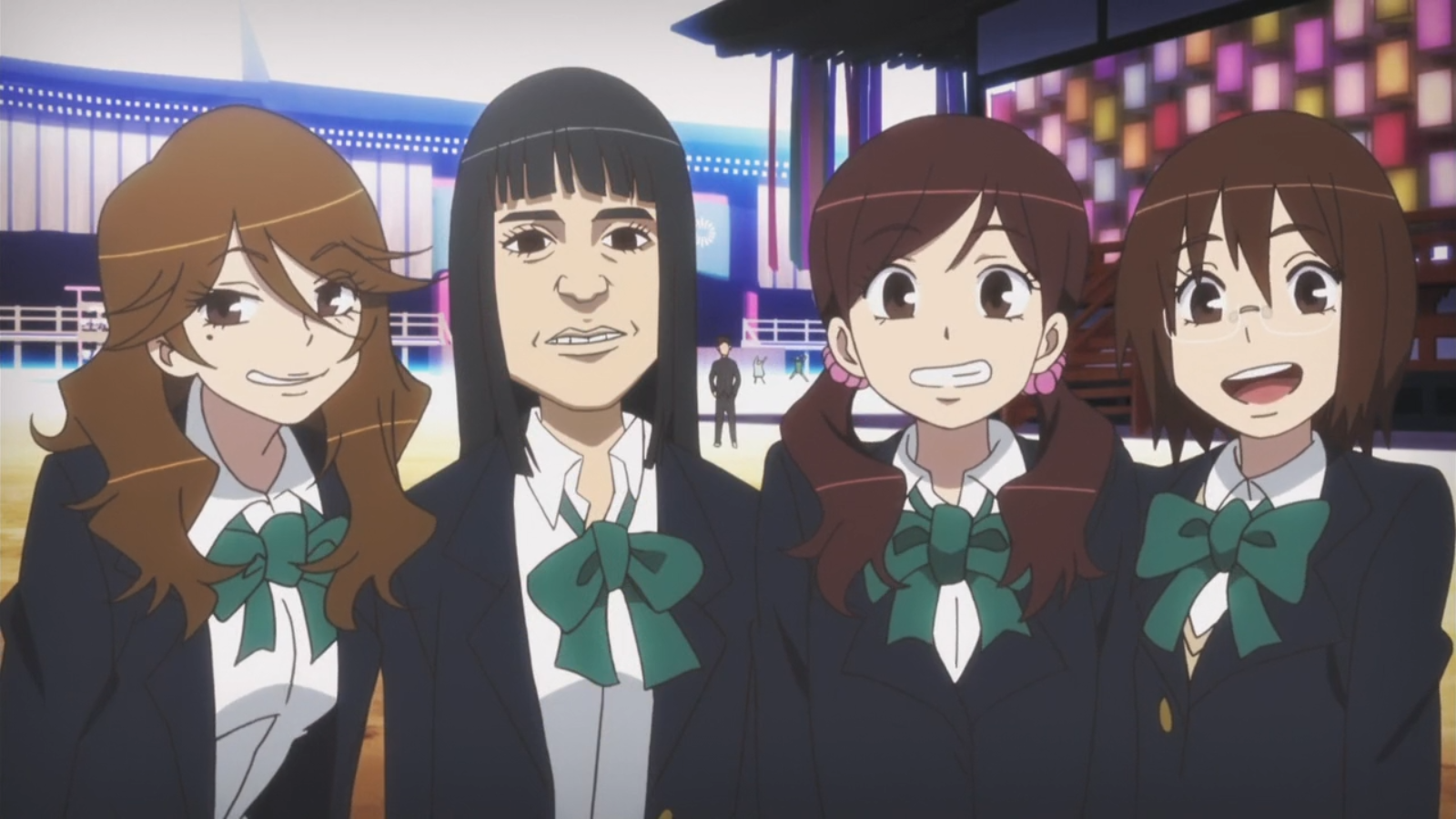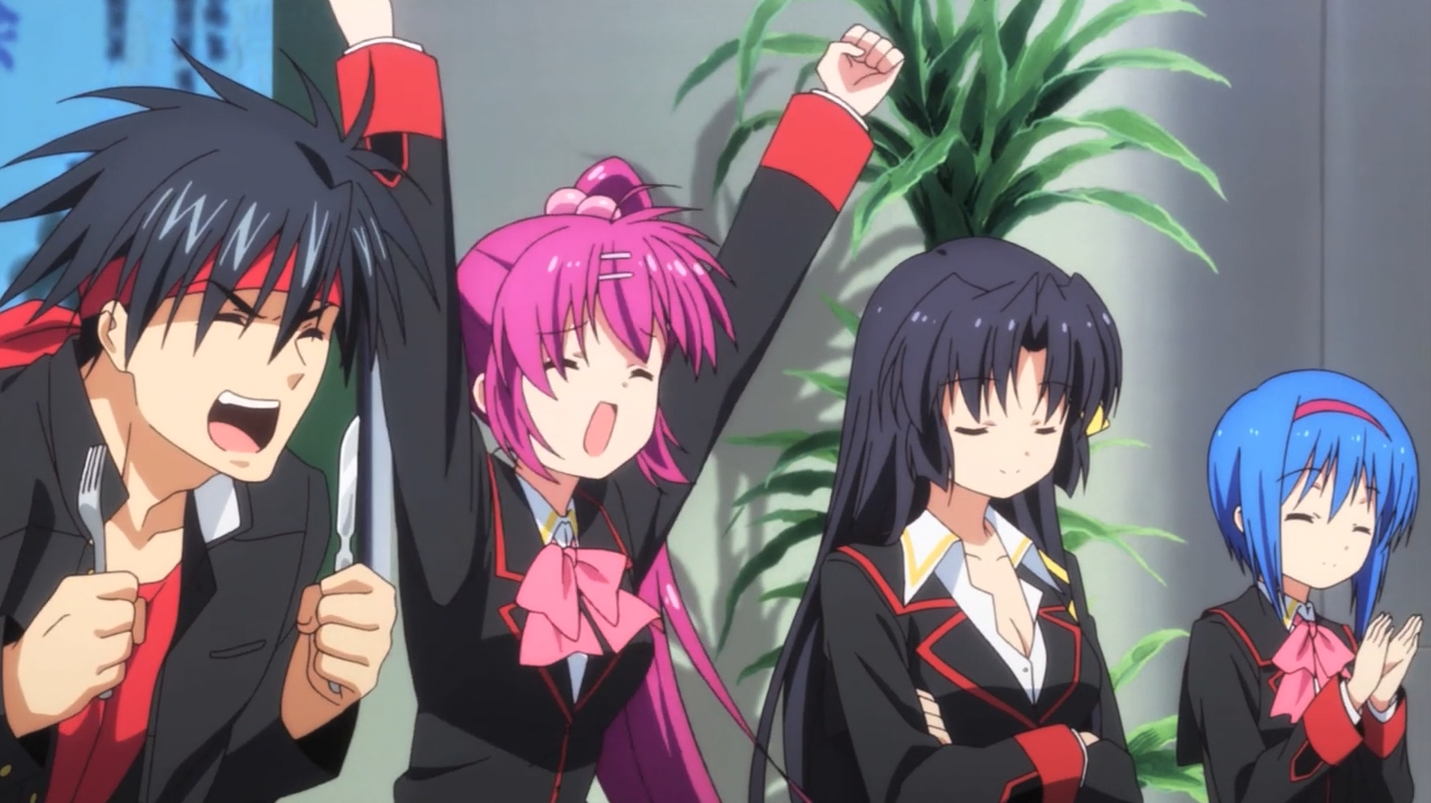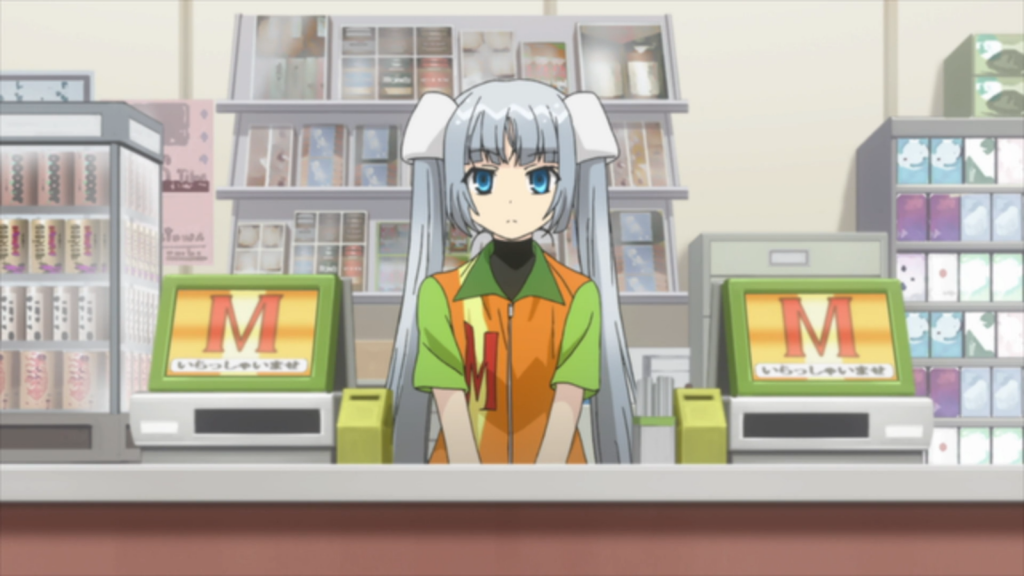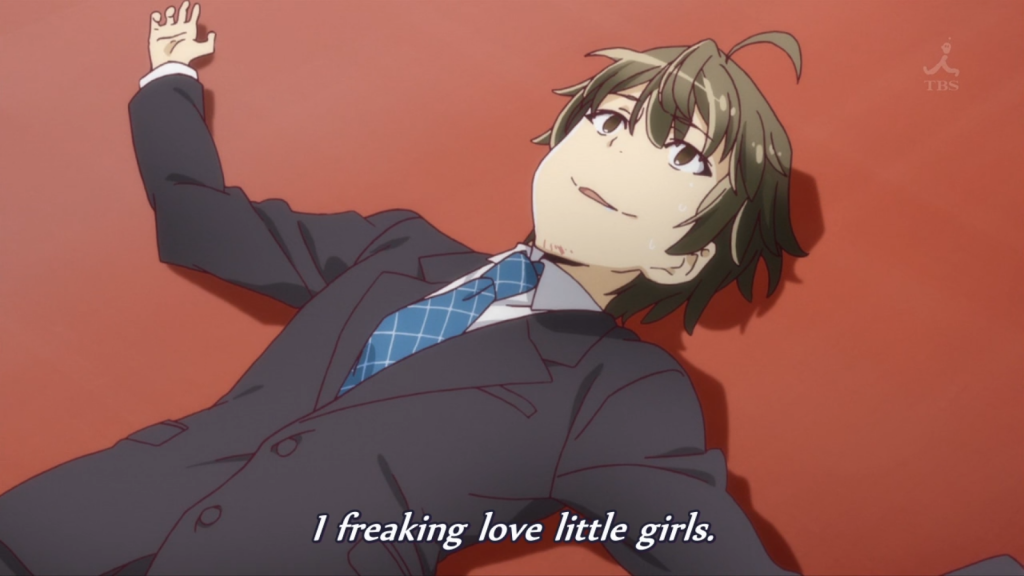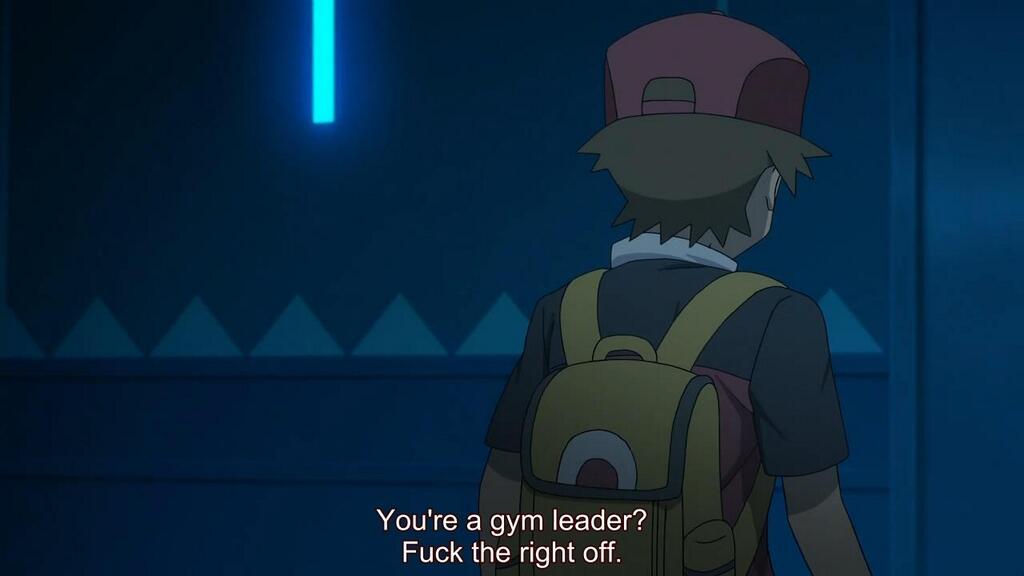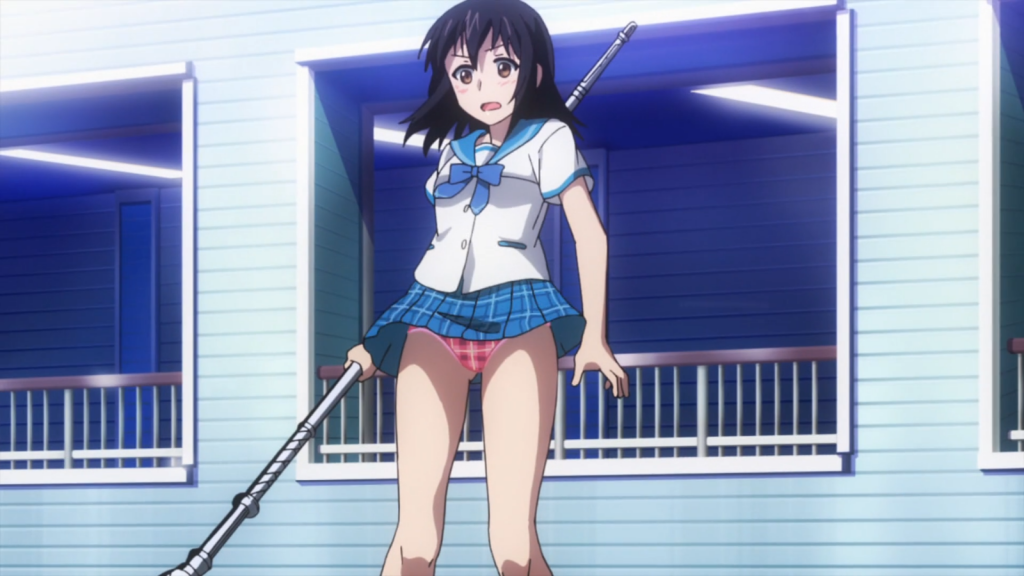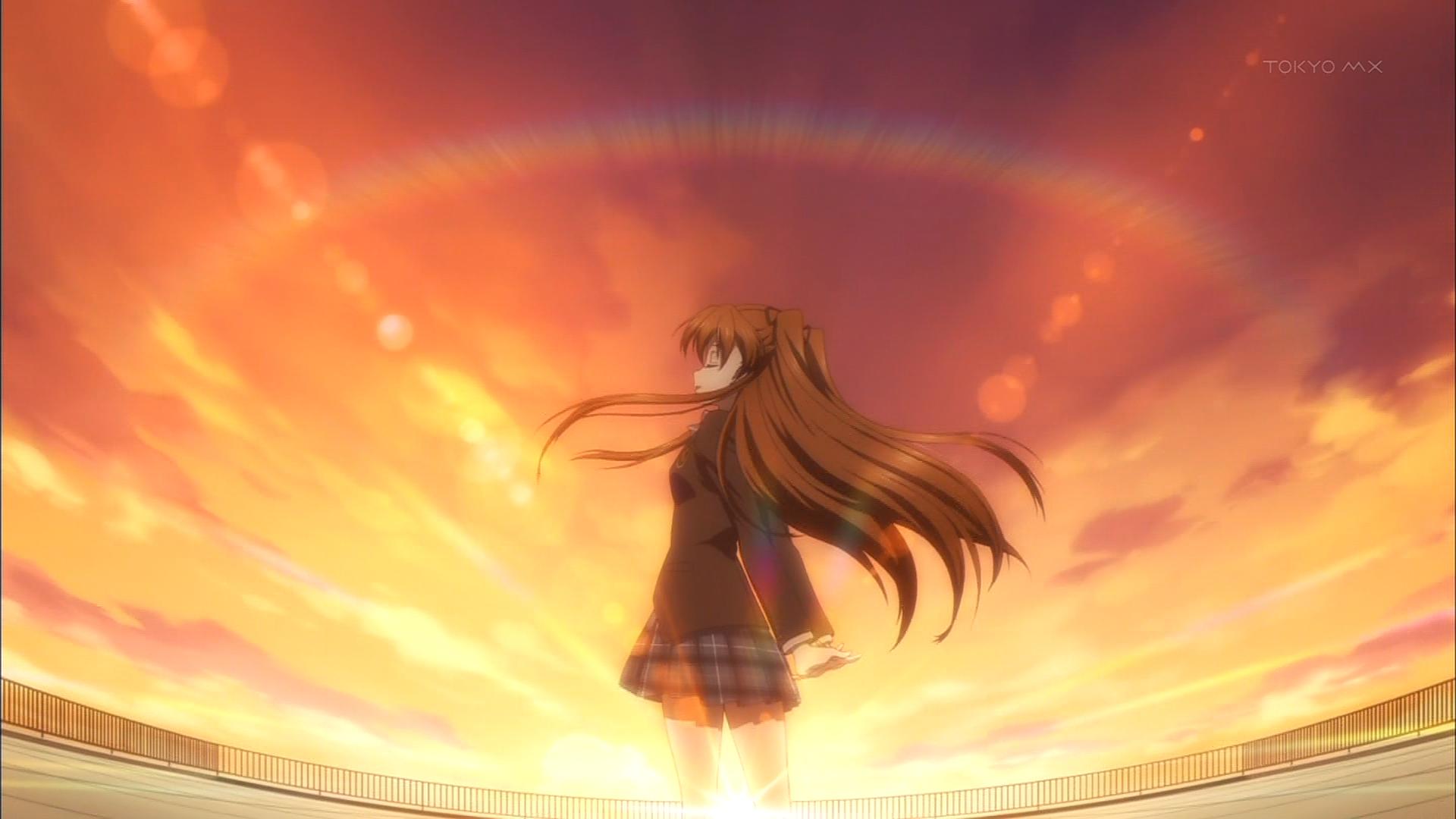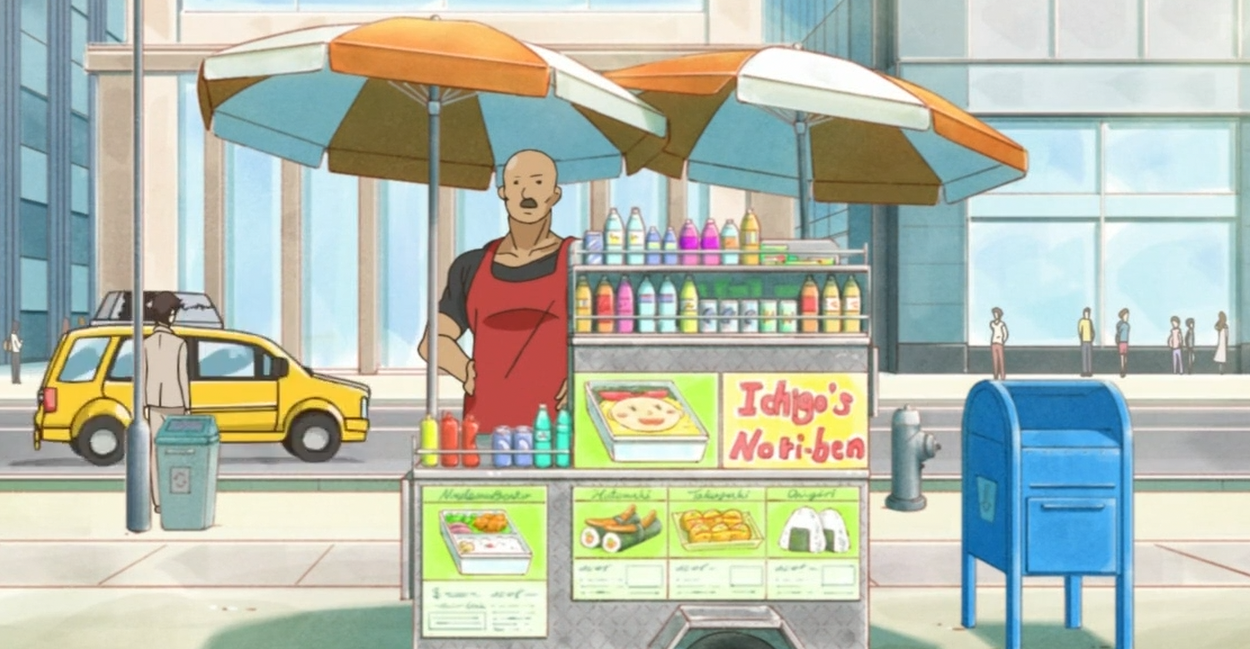10.05
And so begins the first real part of this season’s Clusterfuck. There will probably only be one more unless an anime gets delayed or something.
Beyond The Boundary
So a guy saves a girl from falling down a school, and then he gets attacked for his efforts. Also, he has a not-love interest who hangs out with him out of some sort of pity. But the guy can regenerate his wounds due to being a fusion between a human and a supernatural being, so no biggie. I’d wonder if Golden Week was nigh, but then our main girl Mirai Kuriyama acts like a concoction of moe fetuses with no other desire but to act cute. And there’s no foot focus, Black Scenes, or random shots of dialogue from a novel you can only find on Baka-Tsuki.
But otherwise, this is KyoAni trying to copy its competition. The company that regularly reigns over sales in Japan has to copy Shinbo after doing something decent with Free. It’s not just ripping off Shinbo, but making a bland salute to the latest trend of supernatural slice of life works made in the last four years. It feels like a thirty-year-old guy dressed up as a high school kid, with old hands struggling and failing to copy their successors. Sure, the animation’s good as any other KyoAni work, but it feels phoned in. KyoAni has done the cute moeblob act so many times that they can churn them out with ease. And that’s become their fatal flaw by rendering them unable to do anything else.
By shoving themselves into a corner, Kyoukai no Kanata feels like the worst parts of KyoAni and the latest trends shoved together with no idea of how such a mixture would work. It just feels like moments are slapped together because a successful anime did it a few years ago. And there’s nothing new to the table. Mirai has a bucket land on her head because a cute girl doing stupid things is an old trade from Chuunibyou and Clannad. Mirai can manipulate blood because that sounds like a cool superpower on paper. Mirai has to wear glasses because meganes are what’s in. KyoAni’s proven to be the McDonalds of anime studios. You’re always going to get what you expect, with nothing to savor. — Bloody Marquis
Coppelion
While watching this post-apocalyptic anime, I’m wondering why the three main characters have to be high school girls whose boss is a Vice Principal. I’m further boggled by why the short haired girl and the glasses girl are acting like hyperactive twerps and eating rice balls in the middle of a wasteland. Maybe we’ve gone past the age where post-apocalyptic fiction can be practical, instead subverting elements to make the light moments stand out in the stark atmosphere. It certainly has that effect, quite akin to Gunslinger Girl. Except where Gunslinger Girl mixed nihilism with little girls to create an unsettling, yet unsatisfying effect, Coppelion is watching its steps before doing something with this mixture.
So a majority of the episode is walking. The characters basically walk and talk while either their leader Ibara or the Vice Principal bring out the exposition. While initially slow, it helps bring you into the show’s universe by projecting the absence of civilization. The characters initially come off as slice of life archetypes before the series forces them to realize this isn’t that kind of show. I like how the writers throw a fastball on the characters like that by having a girl more suitable for playing drums in the Light Music Club instead having to inspect an irradiated dead body.
But whether it is a plot point or appeal on the writers’ part, how are they going to explain why the scavengers of society’s ruins happens to be a trio of high-school girls? They aren’t even wearing suits or anything. They’re all wearing regular high school uniforms with skirts galore. Will the show address this? I don’t presume that, but it’d be nice if there was a reason why radiation-immune human beings aren’t Solid Snake lookalikes or something. At least Attack on Titan gave a reason for teenagers in the Survey Corps because they were short on troops.
Speaking of, what’s with the thick lines? The animation was nice otherwise, but the thick lines are quite glaring. Maybe it’s to show how the characters are immune to radiation, or just an oddity on the studio’s part. This might seem like nitpicking, but there’s just something off about that. — Bloody Marquis
Golden Time
An escaped convict from the 90’s, Golden Time is an amalgamation of everything you hated about romantic comedy anime when you were growing up. Unless you’re really young, or really old. But you’ll probably still hate it regardless. There is nothing at all amusing or interesting about this show outside of the poor audio editing (the music and sound effects are much louder than the dialogue) and animation quality that constantly changes from decent to mediocre to abysmal. Even by J.C. Staff standards, Golden Time is unattractive, with awkward-looking character faces and obvious corner-cutting at every turn.
So there’s this guy named Mitsuo and this girl named Kouko who wants him about as badly as I want an English version of Yakuza 5. Unfortunately, Mitsuo hates Kouko with every fiber of his being, so he decided to secretly attend a law school unrelated to the educational path he’d been following since he was a child. Unfortunately for him, and us, Kouko followed him there out of LOVE~, so whacky hijinks ensue almost immediately. Neither of them is the main character, though; instead, we get Banri Tada, a personality vacuum whose name sounds like some kind of drum manufacturer. He makes friends with them both and then other people try to coerce him into joining their clubs and I think I stopped giving a shit around the 13 minute mark.
Make no mistake, this may be a college romantic comedy, but it is no different from any generic high school romantic comedy. Replace all references to universities with ones to high schools and nothing changes. No one acts like a college student, either – one of the girls even behaves as if she belongs in junior high. On that note, none of the characters are likeable. I have no idea why Kouko could possibly be so infatuated with Mitsuo, and I also have no idea why anyone would ever want to be within a 30 yard radius of Kouko. Banri is as bland as the background music, and Chinami’s vocal performance is absolutely grating. Banri’s interactions with Linda are especially cringe-worthy, wrapping up the episode with a thud. That thud being your head as it hits your desk.
If you’re looking for a good romantic comedy to watch this fall, this ain’t it. Search elsewhere. — Foggle
Hajime no Ippo: The Fighting! – Rising
With a handful of a title like that, you know that this series has to be a sequel to something. Indeed, this is yet another season in the highly popular sports anime centered around the up and coming young boxer Ippo Makanouchi and his many obstacles on his path to becoming the world champion of his weight class. With a manga that has been running for over 20 years and is currently just over a thousand chapters long (and still going), it’s no wonder that we get new seasons of this adaptation so irregularly, with the last season having been aired a whole 4 years ago. That said, being that there is so much material from the manga left to work with, the obvious advantage is that we don’t have an anime that takes and entire season just to get one measly fight over with.
Despite being a fan of this series, I have to view this season premiere from the perspective of a newcomer, and judge it on its own merits alone. As a stand-alone episode, at the very least, it does fair quite well. The first half of this season cleverly starts with an important flash-back of Ippo’s childhood. For fans of the series this is a great adaptation of a short story from the manga, and for newcomers it’s a great way to introduce Ippo as a character. That said, there was a bit of a missed opportunity for a stronger narrative, here, in that the episode doesn’t really tie Ippo’s past into his present situation as a boxer, nor does it really convey well enough to the audience just how it relates to his motivation to be a boxer in the first place (something which can be attributed to this flash-back being a bit out of place compared to the strategic point that it was revealed in the manga). That said, I can’t judge this based on the manga, so it’s better to consider this to be an episode of two-halves.
The second half of this episode takes us back to the present, where Ippo is about ready to go into a match to defend his Japanese Featherweight Championship title against his 4th challenger. This is where things can falter a bit for newcomers. If you haven’t seen any of the series leading up to this one, you may not particularly care or even get the significance of this title defense match, not really knowing how tough the business is in the boxing world, nor how hard Ippo had to work his ass off to become the champion in the first place. Furthermore, there is a lot of technical talk about the strategy that the contenders are using in this match, and how Ippo’s opponent plans to destroy his iconic best move, the Dempsey Roll. Unless you happen to be a hardcore boxing fan, or just a fan of this series, you won’t have any clue in just what the hell a Dempsey Roll is (I’d probably think it’s some kind of odd European bread, myself, if I went into this season blind), and wouldn’t give a crap about it’s strategically practical and psychological use in a match. If newcomers will get treated to one thing, though, it’ll be the satisfaction of two muscular dudes Sock’Em-Bopping the shit out of each other!
Unfortunately….the animation quality takes a bit of a cheap turn this season (much like the previous season), and lacks the carefully captured and believable movements of the original anime. For what it is, I think it’s still enough to keep new viewers solidly entertained for at least the first episode, but this probably isn’t enough to get them hooked on the show. In this regard, if you are already a fan of this series and are at least caught up with the first 2 seasons, than watching this premiere (and consequently the rest of this season) is a no-brainer. If you are a complete newcomer, don’t watch to watch 101 TV episodes along with an OVA and a TV movie special, but also still want to check out this premiere if only because it’s current, then by all means see if it manages to peak your interest. As it stands, though, it’s a decent premiere to a series that is more appropriate to watch in bulk rather than with a single episode a week, so take that for what you will. — Ensatsu-ken
Higurashi no Naku Koro ni Kaku: Outbreak
This is the most baffling piece of Higurashi fanfiction I’ve ever seen. Okay, so it’s probably less baffling than that one where Keiichi gives anal birth to his and Ooishi’s demon child, but still. I have no idea what possessed DEEN to make something like this, but it truly proves that even when any and all pedophile fanservice is off the table, they’re still capable of completely missing the point of Higurashi.
The first thing you’ll notice about Kaku (let’s face it, there will never be a part 2) is that it looks terrible. I mean really terrible. We’re talking worse than the first TV series. Even by DEEN standards, the visuals are ass. The backgrounds are a noticeable downgrade from previous episodes, which doesn’t really make sense as I’m pretty sure they’ve always just reused the same ones over and over. The character models look really off half the time, and only a few scant action shots move with any sort of fluidity; even then, I think they just sped up normal footage to make it look less stilted. To make matters worse, while Kira, the previous OVA, was released in HD on Blu-ray, this one was not. Yep, it’s a DVD-only release in late 2013. You can really tell they had a lot of faith in their product.
The plot is completely asinine. Apparently 99% of the world is infected with different types of the parasite that causes Hinamizawa Syndrome from the original story, and a special branch of the government has been brought in to contain/observe/murder everyone infected. Now, I can kind of see what the production staff was going for with this; it seems like they wanted to create a post-apocalyptic survival scenario in order to do an action/adventure take on Higurashi. But being that this is DEEN we’re talking about here, it doesn’t work. Everyone behaves out of character – Keiichi is hardly fazed when Mion is shot and Rena straight up murders three people in front of him – and the main protagonists are made out to be invincible badasses capable of taking down the bad guys without even breaking a sweat.
I found myself consistently scratching my head at the plot developments in Outbreak. There’s a particularly delightful scene about halfway through where Dr. Irie somehow manages to kill 10+ heavily armed soldiers without being injured and then commits suicide in front of Rika by blowing his brains out. Then there’s the part where Keiichi is saved from death by direct shotgun fire because of Satoshi’s bat. Later on, Hanyuu shows up for a total of no more than two minutes to spout metaphorical nonsense and give Yui Horie a cameo appearance. The OVA ends on a monstrously bleak note; everyone in Hinamizawa is dead except for Keiichi, Rena, Mion, Satoko, and Keiichi’s parents, and they arrive at a nearby city only to find it completely destroyed. Oh boy, a cliffhanger. I can hardly wait to find out what’s next.
Outbreak hammers home the fact that DEEN has no idea what made Higurashi and Kai so good. I suppose they figured that because everyone hated Kira, they clearly needed to take their next OVA in the complete opposite direction. They assume that people only liked the original story because of the violence, so that’s what they give you here. Unfortunately, nobody wants to see non-L5 Rena and Keiichi murder people for contrived and downright nonsensical reasons. Violence for violence’s sake is not what Higurashi is about. This may be more watchable than the last OVA, but it certainly isn’t much better. — Foggle
I Couldn’t Become A Hero, So I Reluctantly Decided To Get A Job
Raul trains hard to become a hero and fight the demon lord, but the demon lord gets killed before he even has a chance to graduate from heroin’ school, so now he has to work a shitty retail job instead. This show’s title and plot synopsis invite inevitable comparisons to spring’s excellent Devil Is A Part-Timer, and this first episode begins much the same way, with a surprisingly cool fantasy action sequence that ends all too briefly. But once you get past the prologue, it’s clear that the two anime actually have very little in common. For one thing, the humor in I Couldn’t Become A Hero (henceforth referred to as Yuushibu) is nowhere near the caliber of April’s hilarious tale of devils and fast food, but more glaringly, this one also happens to be an unabashed T&A-fest.
Yuushibu is probably the most frustrating anime of the season for me. It’s by no means a masterpiece, but I rather liked the main characters, some of the jokes actually made me laugh, and the animators clearly put a lot of effort into making it move as fluidly as possible. A couple of weird faces aside, it’s gorgeous, which I suppose is beneficial to those who are looking for a lowest common denominator fanservice show, but I personally found all the ecchi crap obnoxious. There’s a decent slice of life comedy buried here under all the panty shots and boob bouncing, but Yuushibu shoves them in your face so often and so earnestly that they simply can’t be ignored. I suppose if you’re in the market for something to fap and chuckle to this could be your show, but as endearing as certain aspects of it were to me, I probably won’t be checking out any future installments. — Foggle
IS: Infinite Stratos 2
Oh yeah, Infinite Stratos. That sure was a show, wasn’t it? I guess it’s about mechs or something, but 95% of this episode is girls fawning over some non-entity dude and buying clothes. You know, real hard-hitting drama.
So this guy named Ichika has a harem for God knows what reason, and he invites them all to an amusement park. Separately. So they all assume they’re going to go on a date with him. One of them laments that she “isn’t attractive to the opposite sex”, then randomly gets hired to work at a restaurant with her friend. They immediately beat up some robbers while dressed like a maid and butler, respectively. Then she licks crepe cream off her friend’s face. Finally, they dress up in cat pajamas and her friend sexually harasses her. And the Emmy goes to…
This show looks cheap, and that’s probably because it is. The fanservice-filled amusement park stuff – and let’s be honest, that’s what you really wanted to see – all gets shoved to the back of the episode in a slapped-together clip show sort of way. The other 20 minutes meander about doing nothing of merit and are just generally uninteresting or insipid. It’s kind of like the final episode of Aku no Hana in that way, though I must admit that I’d probably rather watch this since at least IS has some modicum of pacing.
I have a hard time stomaching shows such as this one because watching girls attempt to be cute in order to win over some schmuck’s affections is not really my cup of tea. If you like that sort of thing, then I guess you could watch Infinite Stratos 2, but surely there are other, better options out there. This one just comes across to me as a cynical and halfhearted attempt at cashing in on both harem and mecha fans. It does neither genre justice and truly defines the term “mediocre.” — Foggle
Kill la Kill
Over the years, I’ve slowly but surely grown less and less fond of cartoons that don’t take advantage of their medium. What I mean to say is that if a show consists of little more than talking heads in an ordinary, modern day environment, and doesn’t particularly benefit from being animated, I find myself wondering why the writers didn’t just go for a live action series instead. It’s not that I think more realistic or down to earth anime are inherently bad – some of my all-time favorites fall into this category – it’s more that I’d rather see animators embrace the fact that cartoons are inherently different from their shot-on-film counterparts. In that regard, if there’s one person in the anime industry who has yet to disappoint me when it comes to his work, it’s got to be Hiroyuki Imaishi, director of Dead Leaves, Gurren Lagann, Panty & Stocking, and… this show right here.
Kill la Kill explodes onto the screen with a fast-paced, beautifully animated prologue filled with thrilling action and hilarious slapstick. A visual treat on par with many theatrical movies, the first four minutes of KLK alone gave me exactly what I want from an anime. And while the animation quality does dip somewhat from there (though it’s still ridiculously smooth and polished throughout), the episode only gets better once the title pops up. An incredible sense of style permeates every frame; humongous red kanji pop up to introduce the characters, the camera swoops around to find the most exciting angles, the cast members exude confidence and arrogance just by the way they idle about, bright colors and unique character designs flash across the screen. There’s a lot to take in here, and sensory overload is entirely possible. To call the pacing “breakneck” would be an understatement – Kill la Kill covers more ground in 25 minutes than some shows do in five episodes.
The premise is a bit thin and can be described in one all-too-commonly plot-related word – REVENGE! – but the setting is certainly quite something. It’s become a common anime trope for a school’s student council to be all-powerful, and here it is literally a fascist dictatorship, lording over the students with an iron fist and murdering anyone who dares to oppose them. Oh, and their uniforms give them superpowers. Said school resembles a fortress more than anything, and is surrounded by post-apocalyptic-looking slums. One day, a transfer student named Ryuuko Matoi shows up, and the kill la killing begins. Don’t confuse this series for a Battle Royale-style bloodbath, though; the violence is ridiculously over the top and filled with slapstick, even dipping into some classic Looney Tunes-style humor at one point.
The characters aren’t particularly compelling (yet), but I already love Ryuuko as a protagonist. Her mannerisms, facial expressions, and voice acting all come together to create an endearing hero whose tale is simply fun to watch. The villains are all larger than life, humorously arrogant and lacking in any sort of morals or decency – yet despite their absolutely positively eeeeeeviiiiiillllll ways, I can’t bring myself to hate any of them (though this may change later on). They’re just far too exaggerated and silly to outright dislike. Ryuuko’s friend Mako is an anime-ditzy kinda’ girl (you know the type), but somehow even she ends up being funny rather than annoying. That’s quite a feat.
Of course, not everyone is going to dig this kind of thing. I don’t think calling KLK “style over substance” would be correct, as what it lacks in deep writing and characterization it more than makes up for in sheer creativity, but if you’re the kind of person who usually prefers more cerebral programming and doesn’t like turning their brain off for some crazy action, you probably will not care for Kill la Kill. Meanwhile, those of us who never truly grew up, we who love cartoons above all for the zaniness that only animation can provide, will likely await every subsequent episode with bated breath. — Foggle
Second Opinion!
Where do I begin? Well, Trigger, congratulations, you guys didn’t disappoint at all. Kill la Kill, brought to you by the studio that is made up of former Gainax staffers, if you couldn’t tell from the art style and animation already, can be best summed in a single phrase: feckin’ awesome! Though, the funny thing is that despite the marketing efforts for this series emphasize the link to Gurren Lagann (a strong one no doubt) this first episode reminds me more of Diebuster or maybe that’s just me. Granted, this first episode seems to be a ‘greatest hits’ from other past Gainax productions: fight-of-the-week format akin to Panty and Stocking’s monster-of-the-week, striking visuals from Diebuster and Gurren Lagann, as well as the tendency for over-the-top characters and action scenes; the overseeping passion and creativity that very much permeated Gainax during the 2000s (at least the shows that people remember Gainax doing).
Overall, a very good start for what should be a great series to come, I am sure of that. — The Eclectic Dude
Kuroko’s Basketball 2
Now there’s a consistent title. Fuck completely irrelevant subtitles upon already existing irrelevant subtitles, let’s just call it for what it is. Indeed, this is another sequel season in a trilogy of sports anime that I am reviewing, this time based off of another insanely popular, currently-running, shounen manga. And I swear I got the oddest sense of “deja view” while watching this episode. Just like another sports anime from this season that I took a look at, this premiere has about half of it’s run-time devoted to a flash-back. Just like Hajime no Ippo, it’s a good and effective flash-back, but unlike the former, it’ll mean nothing to newcomers. That’s OK, though, because this season makes it upfront and clear that it’s a continuation, through and through, and won’t try to change things around to appeal to anyone who is too lazy to just watch the first 25 episodes of season 1 for free on Crunchy Roll.
Ironically, this season does start off on a fresh point in the story-line that seems like it would be a good jumping off point for newcomers, with the Seirin High School Basketball Club getting ready to start training for the year’s national Winter Cup. The episode even cuts just a little bit of slack for people who already forgot most of season 1, by having the introduction cleverly introduce all of the key basketball players who will be participating in the event. And this is of course where some of you may stop bothering to read this entry immediately. Because, as anime fans, who the fuck really gives a shit about basketball? Well, if you’re new to the mix of sports and anime, it should at least be no secret that it is an incredibly popular formula for a popular and successful series in Japan. The reception that these titles get in other countries, though, can range from passing interests to just plain not giving a shit. America and Canada, from what I can tell, seem to fall into the latter. The best way to describe this stuff, though, is that it’s really no different from a typical battle shounen series at its core. You have players basically taking the place of fighters, and you have absurdly exaggerated techniques (mostly based on real-life techniques) taking the place of special powers. Of course, in this world high school students can pull off feats in sports that are so ridiculous that I have to laugh every time they insist that they are not on the level of professional NBA player. I’ve barely watched any Basketball in my life, but I’m fairly certain that I’ve never seen anyone consistently throw 3-pointers from the other end of a court, or casually make in a basket from BEHIND THE FUCKING BACKBOARD! with ease, while in mid-air. Honestly, I feel like NBA players in this Universe would score by chucking the Basketball over a plane (one that was currently flying) or something and then have it accurately land through the hoop as if it were nothing.
Of course, such ridiculousness is part of this show’s appeal, and can be entertaining in both a hilarious way and yet also a very endearing way as in the best of any battle shounen series. In this premiere episode itself, though, we don’t get a ton of that. We instead get a lot of smart focus on character building. We learn a little bit more about Kuroko, Kagami, and the rest of the team at Seirin and their state of mind for how they plan to dominate their way through the Winter Cup. At the same time we get to learn about some of their upcoming opponents, and in this episode we get to meet an old friend of Kagami’s, as well as Kuroko’s old teammate. The rest of the episode then primarily focuses on Kagami’s history with his so-called “brother,” and while the flash-back itself is interesting enough, I have to be honest and say that the most interesting thing about it was easily the seiyuus’ broken use of “Engrish” that just never fails to amuse me (especially since Kagami’s back-story takes place in America….so there’s A LOT OF IT). It’s not quite as awful as in Black Lagoon, and therefore not nearly as hilarious, but it still manages to give me a kick or two.
At any rate, after we get all of the exposition out of the way, we finally see the two parties get ready for a street-ball showdown, and then….the episode ends. Yeah….kind of an anti-climactic tease that you get used to in shounen series of this nature. It’s a bit disappointing because it would have been nice to see if this season could keep up with or even improve upon some of the stellar and life-like animations of the first season for the basketball games, but as it stands it serves as a great continuation point for those who thoroughly enjoyed the first offering of this anime series. And that’s pretty much where it stands, all things considered. If you liked the first season, then watch this one. If you haven’t even seen the first season, then check that out to see if it’s your thing or not, otherwise you can try this one if you feel so bold, but you’ll probably have a harder time finding a reason to give a shit about what’s going on in that case. — Ensatsu-ken
Kyousougiga
At first glance, Kyosougiga desperately wants to be Gurren Lagann with its neon oversaturated color scheme and Western influenced aesthetics. However… this being Toei, it comes with that usual faster cheaper cheaper fast production quality that somehow makes it look lazier than a Shaft show. The series originated a few years ago as a series of ONAs in colaboration with Bandai’s video game subsidiary Banpresto and I did attempt to watch those in preparation for this entry, however I found myself unable to follow the thing due to the blinding color scheme and the fact that what plot there was made little to no sense.
Alas this is a problem that is carried over to Kyosougiga The Series.
Our story (what little of which can be gleaned from the sheer randomness of the rest of it) concerns fiesty young Koto and her two clingy brothers as they try to escape from The Capitol, a bizarre alternative Kyoto inhabited by gods and demons which is either supposed to be purgatory or some old 80’s RPG (the show suggests both). Soon Koto gets dragged into the internal strife of the Council of Three, a pair of priests and a incredibly posh demon who simply whack each other with sticks. Now this episode claims to be a recap of the original web shorts but I literally do not remember any of it and it goes by so damn quickly that I have even less of an idea as to what the hell is going on with this show. It doesn’t really matter though because next week’s episode looks to be completely different, begging the question of what the hell was the point of this week. At least Rozen Maiden got away with it last season by making the first episode a legitimate fake-out.
Now as I have stated in the past I am not a fan of so-called “art anime” as they frequently (Madoka excepted) eschew logical narratives and plot structure for weirdness and/or Shinkai-esque “look at me and my pretty screensavers!” Kyosougiga falls into that former category and of course looks even cheaper because Toei. Add to the fact that over the course of the 25 minute run time I could not follow what was going on or even really cared to makes this show a case of style failing to overcome gross indifference. If you like this kind of show then fine but this is where I get off. — Lord Dalek
Little Busters! Refrain
Despite enjoying the first episode of the previous season quite a bit, I have a real love/hate relationship with Little Busters. There are so many things I like about it, and yet so many things I detest as well. One minute I’ll be thinking, “hey, this show is pretty good!” and the next I’ll be moving for the “X” button. The first installment of Refrain showcases this divide perfectly. On one hand, it’s got some legitimately fun slice of life antics to smile at, but on the other, it has terrible metaphorical BS dialogue punctuating every scene. Half the cast are likeable buddies I’d love to hang out with, but the other half are annoying moeblobs. Some of the human drama is legitimately interesting and emotional, but the rest feels forced and fake.
I will say this for Little Busters: it’s a lot more realistic than other Key works like Clannad. Many of the characters in this one actually resemble people I’ve met or could potentially meet, and the high school shenanigans they get into remind me of my own days in the public education system. My biggest problem with past Key stuff has always been that it feels like it was written by someone who had never actually attended high school and was just guessing as to what it was like. I don’t get that feeling here. For a few fleeting moments during the pancake party scene, I caught myself reminiscing on days long past, – “oh, this is just like the time my friends and I…” – which proves that Jun Maeda and whomever else did a good job with the writing there. And while the resolution was a bit silly (though admittedly badass), Kurugaya’s problem in the second half of the episode was shockingly believable and well done.
Sadly, I also found myself groaning multiple times throughout the episode, as usual. Riki’s internal monologues are so self-indulgent and obnoxious that they almost killed my interest in both the plot and characters entirely on their own. Then at the end when his narcolepsy randomly hits him… really? I mean, I understand how the disorder works and that it can practically knock you out at any time, but this is just classic Key forced drama, plain and simple. Clannad, Kanon, et al. are overflowing with stuff like this, and Little Busters!, while better written in other areas, is no different. It is unfortunate that Maeda and co. are still resorting to cheap tactics like this rather than finding more natural and inventive ways to make people cry.
Visually, Little Busters! Refrain is no award-winner, but it’s clear that this is where J.C. Staff poured most of their Golden Time budget. It’s undeniably attractive in a simple sort of way, mostly due to how colorful it is; just make sure not to expect KyoAni quality and you probably won’t be disappointed (and hey, at least it looks better than Toei!).
If you like Key stuff, you’ve probably already watched this episode and maybe even read the visual novel it’s based on. If you don’t, Little Busters! probably won’t change your mind, but if you’re like me, you might think more highly of it than past productions. For everyone else, you could certainly do worse this season. Despite the very big problems I have with it, it’s not a bad series by any measure. — Foggle
Log Horizon
Several hundred thousand players of the MMO Elder Tale go to sleep one night only to find the real world suddenly transformed into that of the game (exactly how and why hasn’t been explained but it may have something to do with an expansion pack). Our focus is on three of them: cleric and lead protagonist Shiroe, swordsman and tank Naotsugu, and ninja assassin loli (and unofficial series star) Akatsuki. Together these three people who associated off and on in the past when the game was simply sprites on a computer screen must partner together to survive in what has now become reality.
When approaching a show like Log Horizon one obviously must bring up the age old question… How similar is this to that OTHER show from last year? Well both Log Horizon and Sword Art Online have similar origins as web novels that got published but the latter predates this work by several years (2002 vs. 2010). That’s actually to Log Horizon’s credit as it often feels more like a response to Kawahara and what he did wrong with Sword Art rather than trying to cash in on it. For one, a lot of the noob tutorial crap that colored SAO’s first episode is just not there. These guys have been playing this game for a while and clearly know what they’re doing (also no beater shit thank god). Also making the cast seem more like an ensemble versus one nigh invincible solo player and various emotionally conflicted girls drawn to him like magnets is a MAJOR step in the right direction. Heck this was actually somewhat entertaining. Can’t even begin to say about Sword Art’s bland first show.
If anything Log Horizon owes a debt of influence to, its probably Final Fantasy Tactics Advance. For those who do not recall that was the one where a bunch of school kids wished their town would turn into the setting of Vagrant Saga and then our main protagonist had to fight the person behind it to get it to turn back. While I doubt Log Horizon will eventually go in that direction, it’s still an obvious sign of what we all thought it was going be: a ripoff. That being said, the fact that the first episode was probably better than it had any right to be suggests it might be worth giving a chance. — Lord Dalek
Miss Monochrome: The Animation
In this season’s edition of The Yui Horie Show created by(!) and starring Yui (what a dirty w)Horie, Miss Monochrome, a Vocaloid worth 16.2 billion yen loses all her cash and her Xanadu-esque palace when her “best friend” takes her for a ride. This leaves poor Monochrome out on the street with only a roomba and a day job at a convenience store to help her claw her way back up to Roppongi. It’s four minutes long and you could do worse, but DD Fist of the North Star still did this concept better and was actually funny to boot. — Lord Dalek
Nagi no Asukara
One day, Mari Okada watched Gargantia. The wonderful first and last episode with a slog in-between convinced the writer that she could do much better. Surely, she can outdo that silly Urobuchi when it comes to writing an anime about the sea and prejudice. And through years of writing cute characters that never react to problems like real human beings; she had the girth to challenge that dummy Gen. With an underwater setting here and some random land-vs-sea racism there, she was ready to begin her latest work that will surely move the audiences to tears. And that’s where we find the plain series known as Nagi no Asukara.
This show really wants to be whimsical. Every scene has a moment that tries to be otherworldly, but only proves to be a background for some one-note characters going through their teenage angst. Take the underwater setting out, and it’s just boring kids acting like boring kids. The series does make some effort in incorporating the premise instead of relegating it to the back, but those moments are usually for humor instead of anything that could grab the audience. A girl runs away from school because some kids are bullying her, which would be interesting if not for a farting fish knee being the catalyst. It’s just like that moment in AnoHana where Yukiatsu crossdressed to deal with Menma’s loss. Mari Okada’s shows almost always want to be taken like the pristine dramedies she wants them to be, but then she decides to add something eccentric for the sake of melodrama.
And while her style is hackneyed and worse than what comes out of a Key Visual Novel, she keeps on doing it as if nobody’s given her any criticism. Her shows keep doing the same problems, but with no improvement over the years. Mocking this show feels just like mocking Hanasaku Iroha or Fractale. Mari Okada just recycles concepts with a different setting every now and then to give the illusion of freshness. She does do something good once in a while like Fujiko Mine, but those come in a blue moon. — Bloody Marquis
Outbreak Company
HOOOOOOOOO BOY! Where do I begin with this one? Outbreak Company is one the most puerile, disgusting, shameless, depraved collections of ink and paint drawings ever collected in a sequence of 24 minute chunks. Very few shows get as bad as this. Very few shows get even WORSE than this (*cough*Flowers of Evil*cough*). What did I do to deserve this?
THE STORY SO FAR: The Japanese government has discovered a wormhole into a fantasy land where everybody has elf ears and rides on choco-oh fuck it. To maintain diplomatic relationships with this Holy Eldant Empire, they’ve proposed a cultural exchange. Eldant will start getting a load of anime, light novels, and dating sims in exchange for… honestly I don’t know. To oversee this, some random NEET has been dragged off the street and denied a trip home until he makes quota. There’s also some elf girl who’s a maid and some bitch empress, I don’t know.
THIS SHOW IS BAAAAAAAAAAAAAAAD. Its like they took everything I hated from Dog Days and the Fairy Dance arc of SAO and said “Hey! Lets just have all of this crap in this show!” Its the kind of terrible that makes me wanna fling myself off the top of a very tall building. Now if you excuse me, I need to go drown my sorrows in a Hiroyuki Imaishi TOTALLY NOT RAPE scene. — Lord Dalek
Pokémon Origins
It’s almost hard to believe that the Pokémon franchise has been around for over seventeen years. But with over 60 titles, a trading card game, and an ongoing anime and manga, Pokemon has forever made its place in history as one of the most successful gaming franchises of all-time, second only to Mario. Not bad for a concept that spent years in development hell. And with the sixth generation launching this Saturday, Nintendo and The Pokemon Company have been going all out with promoting it and reminding us why we should continue to throw money at them. Unsurprisingly, one of these efforts includes a four-part animated special. However, rather than focus solely on the upcoming generation or give us a heaping helping of Ash, the focus is on the two games that started it all. And furthermore, and most surprising of all, not only is this special — entitled Pokémon Origins — a wonderful alternate look at the world of Pokémon, but it is also one of the best anime I’ve watched all year (Kill la Kill notwithstanding).
Faithfully following the plot of 1996’s Pokémon Red and Green, Pokémon Origins follows the journey of young Red, as he aims to complete the Pokédex and become one of the greatest trainers in the world. But from almost getting his Charmander killed, to using a Spearow against Onix, it’s clear that he has a lot to learn. But with only four episodes to work with, and a game with a plot that expands at least ten hours of gameplay, how do the writers handle showing all that growth? Montages, of course! But strangely enough, this method of storytelling doesn’t detract from how well things such as the rivalry between Red & Green and the encounters with Giovanni were done. All the moments they decided needed proper attention got that proper attention. The mother Marowak dying. The conversation between Red and Giovanni in a destroyed Silph Co. building. The final fight between Mewtwo and Mega Charizard X. All of that and more channeled the atmosphere of the games to create some pretty heavy character moments and action-packed scenes that make me wish the Origins special could replace the anime proper. Pokémon Origins has an enjoyable story that truly respects the source material and tries to get the most it can out of it in the allotted time.
Thanks to the core of the story already having been written years ago by Satoshi Tajiri, Production I.G. and the other animation studios involved with the project were able to spend more time to make the region of Kanto come to life. Each part of the special has wonderful animation, especially when it comes to the battles, which are fast-paced and cinematic. Every location has a very clear feel just from the colouring and lighting; even the Pokémon Mansion that was only seen in a montage and two flashbacks manages to capture the air of mystery that you were able to get from playing the old games back in the day. The score is filled with orchestral versions of many of Red/Green’s greatest tracks that brought back great memories of playing Pokémon until my cartridge stopped working. And I suppose that was the goal: to induce that nostalgic feeling in the viewer. Many of the people running to watch this special aren’t the younger players after all. It’s the teenagers and adults that grew up with the franchise and remember its heyday and shaky roots that this special is truly aimed at. It’s a reminder of how this whole thing got started…while also reminding us where the franchise is heading, with Mega Evolution playing a major part in the climax of the final episode.
With my red Pokémon special edition 3DS XL in tow, and my pre-order for Pokemon X set, I’m ready to enter the sixth generation of the franchise. But it’s always nice to go back and reminisce about the past, and Pokémon Origins does a perfect job of helping us all remember why we love these crazy Pocket Monsters in the first place. Eight badges. 150 Pokémon caught. Play Time: 35:46. Save and continue? YES. — RacattackForce
Strike The Blood
Several miles off shore from Tokyo lies Itogami Island, where all the nation’s monsters have been collected and dumped (sadly this does not include Godzilla and Rodan). One of these monsters is a “primogenitor” (a sort of super vampire) named Kojou Akatsuki whom the government has decided must be eliminated at all cost. To do this, they have sent an assassin known as a sword shaman to carry out the task….unfortunately for us, said Sword Shaman is a slightly dim high school girl named Himeragi who has Railgun powers apparently. Comedy ensues…or not.
In a season where Coppelion and Kill la Kill are raising the stakes (or at least trying to), Strike the Blood comes off as being… well… typical. Its not a bad show persay but its the kind of anime you’ve seen dozens of times before and will see dozens of times again. The kind where you just find yourself shrugging your shoulders at the end. How was it? It was ok. How are the character designs? They’re ok. How’s the animation? It’s…ok… EXCEPT… For whatever reason Silver Link has employed a weird coloring scheme for this show’s action scenes where red and green bands occasionally appear on the sides of characters’ faces like an old misaligned three-strip Technicolor print or a 3D movie if you didn’t have your glasses on. It is literally the only thing notable in this bland forgettable series.
All in all, while you won’t hate yourself after watching Strike the Blood, you likely won’t remember any of it either. — Lord Dalek
White Album 2
This is an anime from 2004 that someone just discovered, right? The animation and writing look like those melodramatic shows from a decade ago. Main guy Haruki wants to play the guitar for his sweetheart, but angst is getting in the way. Rosy music plays non-stop. Long scenes play out with him talking to his friends like the romantic foils they are while he mutters to himself for the entire episode. And surely, those trends have long since been subverted by now. Someone has genuinely done an accurate job in making an anime from nine years ago. Certainly, I would applaud that effort if this were intentional. You can’t find period pieces as meticulous as this, and I am marveled by how much the show feels like an anime from the early 2000s.
Oh, yeah. The plot. Uh, I guess Haruki dates the boring girl after 11 episodes of being an indecisive doormat. And somebody has dead parents or something. He’ll either reign in the Light Music Club while earning the passion of his love interest. Or he’ll suffer from mediocrity as the girl consoles him and says that it doesn’t matter how well he plays guitar, but how he sings through his heart. Or something cheesy like that. I don’t know. — Bloody Marquis
Gaist Crusher
So I’ve been meaning to wait until Gaist Crusher has been subbed and simulcasted for about a couple of days since it was released. Yet after two days it had yet to let it happen to him. So I had to bite the bullet and watch the darn thing raw and figure out if it was worth it. Then I realized why it hasn’t been subbed in the first place…
Our cadre of armoured heroes with superpowers fighting a malevolent mystical force known as Gaist… have no vaginas.
…NO WONDER THIS HASN’T BEEN SIMULCASTED! It’s just a bunch of prepubescent dicks flying around in gaudy armour defeating stupid shit. You can’t sell a $50 figure with unnatural articulation with that cock and balls garbage!
FUCK! So there’s this kid I think his name is Recca but in the non-existent English dub by Saban he’ll probably be Ricky, is some kid who gets caught up in Gaist Crusher because the main Gaist Crushers are not strong enough or something and he’s apparently the chosen one since the gem chose him. Then he beats the Gaist, then sleeps.
WHAT IS THIS BULLSHIT!? Really there’s no faffing around talking about mundane things like Mayonnaise and bath scenes. Who wants this crap? I don’t, and neither should you. Let the stupid kids look into it and buy the cheap $10 toys while we stick with the Vividreds of our age and splurge that $50 on that needlessly articulate action figure.
Honest One-Sentence Review: It’s a dumb procedural kids anime with toyetic armour and enemies that wants to compel your kid to buy it at whatever Japanese toy store is nearby. But you’re not in Japan are you? So don’t bother. — The Juude
Freezing Vibration
I watched this anime right after Gaist Crusher. It’s a major improvement over that due to it correcting the fatal flaw of having main super-powered protagonists brandish cock and balls. Now THIS is what I’m talking about, superpowered beings with breasts and vaginas (I think they’re called garlz or something, it’s probably French for “superpowered beings with breasts and vaginas”) who hang around naked and volt texture clothing onto themselves but never enough to hide their panties (I think that’s German for “Vagina Shields”).
Unfortunately everything else is just boring as shit. It’s Counter-Revolutionary Girl Utena with a Eugenics bent where garlz (or it’s Italian variation “wommun”) are trained to magic clothing and weapons onto them to fight evil monsters known as Nova. Usually at the premiere of a second season, the onus of the show as it begins in media res is to hopefully entice new people, but it’s not so here. Most of it is just spent on boring battles in the snow and hopeless exposition with the occasional flash of tits and minge.
The title says it’s “Freezing Vibration”, which is true, because it left me really cold and shivering from the lack of any emotional attachment or euphoria to be found. — The Juude
Aikatsu! 2
GAWD COCK AND BALLS! THEY GET EVERYWHERE I HATE THEM!
THANK GOD THE FINAL ENTRY IN THIS CLUSTERFUCK DOESN’T INVOLVE ANY STUPID COCK AND BALLS! FUCK YEAH AIKATSU SEASON 2! FUCK YEAH! FUCK YEAH!
FUCK YEA—it’s boring really. Like Gaist Crusher it’s a kid’s show, only it’s directed toward those so-called garlz. It’s really inoffensive Bechdel Test passing tripe about doing your best, competing as idols, and gathering cheap toyetic cards so characters can dress up and perform a rote pop song with rote CG work. You can do a lot better, you can do a lot worse, or you can just do. And nobody likes to just… do in this regard. Leave this to the Japanese girls demographic to buy, trade, and sell with each other at whatever Japanese toy store nearby.
But remember, you’re not in Japan are you? So don’t fucking bother we’ve already been through this. Did you not listen to me you sack of shit? Don’t lie to me or else I’m coming home to belt you for once again not listening. Fuck if you’re not in Japan, and this is not there, and there is not this, don’t bother. It’s as simple as that douchebag.
It’s as simple as that. — The Juude
